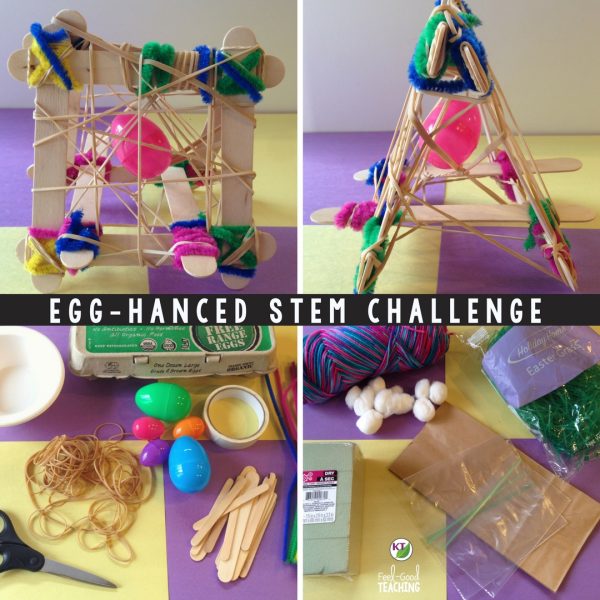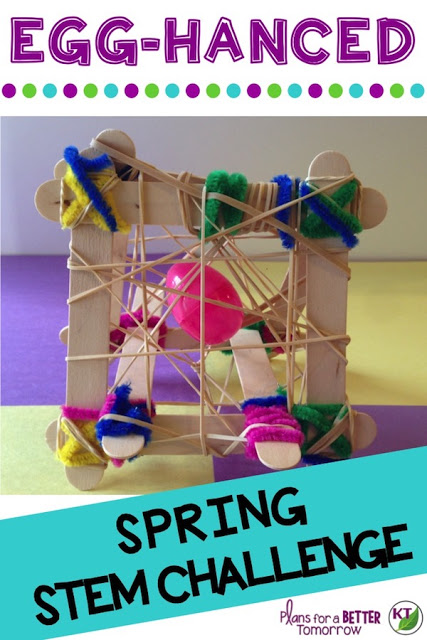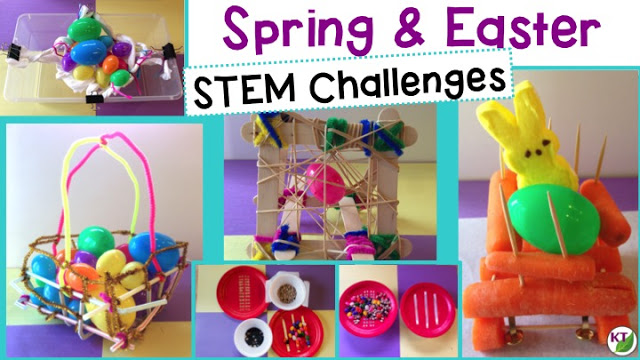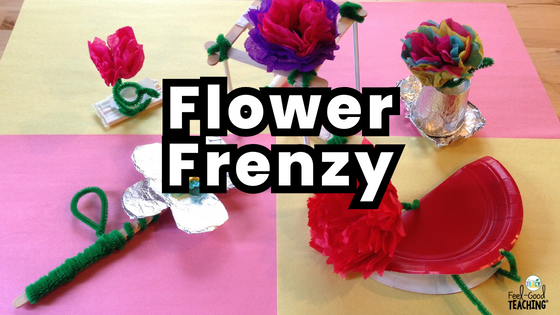This STEM challenge is a classic egg drop, making it perfect for any time in spring, including — but not limited to — Easter! I fondly remember doing this challenge when I was in kindergarten — before “STEM Challenges” were a thing! I also recall the best design (not mine) used blown-up balloons to make for a very light-weight, protective housing for the egg. I was so jealous of how clever that was!
Now, I have to marvel at it; a good 20 years before I saw my first plastic bag of air in a shipping container, one of my classmates could have been its inventor! At five years old, that’s pretty darn impressive!
Premise
Working against a criteria & constraints list, students design an egg-hancement to protect it from drops at ever-increasing heights! There are a variety of materials & options described in the video below to make this spring challenge easier or more difficult. Since this is a classic, I’ve added in a few ideas to make it a bit more interesting and challenging!
Materials
Note: The links below are Amazon Affiliate links. Find out more on the disclosure page.


- Eggs (1 – 3)
- Real or plastic (if you choose plastic, you’ll want to fill the eggs with beans, rice, or sand)
- Soft/protective materials
- Easter grass, cotton, tissue paper, floral foam, packing peanuts, etc.)
- Small cups or bowls (1)
- Craft sticks (5 – 10)
- Pipe cleaners (5 – 10)
- String/yarn (24 – 36 in.)
- Tape (12 – 24 in.)
- Rubber bands (5 – 10)
- Scissors
- Scale
- Design analysis handouts (included in resource)
Optional
- Plastic baggies (1 – 2)
- Paper bags (1 – 2)
- Coffee filters ( 2 – 4)
Where Can I Find Out More?
Rather than write it all down for you to read, wouldn’t it be nicer to just sit back and watch? I’ve found creating video walk-throughs of my STEM challenges is the best/fastest way to explain the important details: materials, set-up, tips, modifications, extensions, and more! Check out the video below to learn more about Egg-hanced. However, if you prefer to read, you’ll find the video transcribed at the end of this post.
Are There Other Spring Activities Like This?
Of course! I can’t help myself! I have created 5 challenges for Easter & spring (with plans for a few more coming soon)! You can find the overview of each on this blog post.
Video Transcription
Hi there. Welcome to week two of the Easter and Spring STEM challenges. Today, we
are doing Egg-hanced, which is a classic egg drop. I do have a few new ideas to
keep it a little bit fresh and interesting. Before I get ahead of myself, let’s
check out of the materials and the STEM Challenge Cycle.
are doing Egg-hanced, which is a classic egg drop. I do have a few new ideas to
keep it a little bit fresh and interesting. Before I get ahead of myself, let’s
check out of the materials and the STEM Challenge Cycle.
This is the STEM Challenge Cycle you should follow for every challenge. I’ve defined
each step in another video. I’ve added a pop-in card to that video here, as
well as a link in the description.
each step in another video. I’ve added a pop-in card to that video here, as
well as a link in the description.
Now, if you’re trying to avoid Easter themes in your classroom, there really isn’t
anything Easter about this challenge other than the fact that we’re using eggs.
I do have one example here where I’ve used Easter grass, but you don’t need to
do that.
anything Easter about this challenge other than the fact that we’re using eggs.
I do have one example here where I’ve used Easter grass, but you don’t need to
do that.
If you’re doing this the classic way, then you are probably using real eggs. You
can either use those raw or you can hard boil them. If the idea of using real
eggs bums you out, either because of the mess or just wasting the food, I
completely get it. In these examples, you’ll see that I used plastic eggs, and
I filled them up with beans ahead of time. Another option to avoid mess if you
are using real eggs is just to have the students enclose their designs in a
Ziploc bag or a plastic bag prior to testing. That should contain all the goo.
can either use those raw or you can hard boil them. If the idea of using real
eggs bums you out, either because of the mess or just wasting the food, I
completely get it. In these examples, you’ll see that I used plastic eggs, and
I filled them up with beans ahead of time. Another option to avoid mess if you
are using real eggs is just to have the students enclose their designs in a
Ziploc bag or a plastic bag prior to testing. That should contain all the goo.
Because this is a classic challenge, in fact, I remember doing this myself as a student
in kindergarten, you’re not going to want to tip your hand ahead of time to let
the kids know what you’re going to do because they can look online, on YouTube
and other places, to see designs that are already done. That will stump their
own creativity and innovation.
in kindergarten, you’re not going to want to tip your hand ahead of time to let
the kids know what you’re going to do because they can look online, on YouTube
and other places, to see designs that are already done. That will stump their
own creativity and innovation.
For the base criteria and constraints, keeping it very simple, you want to build
something to protect an egg so that when you drop it from a given height, it
doesn’t crack. When I was in kindergarten, we took that one step further and
made it so that once we saw all the eggs that survived the drop, we weighed
them all, and the lightest design won. Another way you can handle that is just
to add a criterion that the total weight of the design plus the egg must be no
more than twice the egg, in which case you would weigh the egg first,
obviously, so the students know how much they’re working with.
something to protect an egg so that when you drop it from a given height, it
doesn’t crack. When I was in kindergarten, we took that one step further and
made it so that once we saw all the eggs that survived the drop, we weighed
them all, and the lightest design won. Another way you can handle that is just
to add a criterion that the total weight of the design plus the egg must be no
more than twice the egg, in which case you would weigh the egg first,
obviously, so the students know how much they’re working with.
If you want to make this challenge a little bit more difficult, there are several
things you can do. One thing is to increase the height that the egg must
survive the drop from. You can require that the student’s design actually house
more than one egg and protect them both from being cracked. Another thing you
can do is require that some part of the egg actually be visible. Probably
wouldn’t add that one for younger students. I allow them to completely contain
their designs. Of course, we can also tighten up that criterion about the
weight. Instead of saying that your design can be twice the design of the egg,
maybe it can only be 25% the weight of the egg.
things you can do. One thing is to increase the height that the egg must
survive the drop from. You can require that the student’s design actually house
more than one egg and protect them both from being cracked. Another thing you
can do is require that some part of the egg actually be visible. Probably
wouldn’t add that one for younger students. I allow them to completely contain
their designs. Of course, we can also tighten up that criterion about the
weight. Instead of saying that your design can be twice the design of the egg,
maybe it can only be 25% the weight of the egg.
Particularly if you have older students, this is a great opportunity to do an impossible
challenge. Since the egg drop is a classic, they’re probably familiar with it
on some level. It won’t be completely new to them. So what you can do is make
it an impossible challenge by giving them a set of materials that even you
don’t think will work. This design is actually inspired by such an impossible
challenge. We have just a few craft sticks, a pipe cleaner, actually maybe two
pipe cleaners, and some rubber bands, and a lunch bag. I don’t know how it’s
going to perform yet. We’ll have to wait and see.
challenge. Since the egg drop is a classic, they’re probably familiar with it
on some level. It won’t be completely new to them. So what you can do is make
it an impossible challenge by giving them a set of materials that even you
don’t think will work. This design is actually inspired by such an impossible
challenge. We have just a few craft sticks, a pipe cleaner, actually maybe two
pipe cleaners, and some rubber bands, and a lunch bag. I don’t know how it’s
going to perform yet. We’ll have to wait and see.
When it comes time to measure the results of their designs, I recommend not just
doing one height drop that’s very large. Instead, I like to set up three
incremental heights. These give students more opportunities to be successful at
different levels. Students will test their design at ever increasing heights
until their design finally does fail and the egg cracks. If there are any
designs that are successful at every height, you can continue to test until the
failure point of the design or you can then challenge the students to come up
with another design that is maybe 75% of the weight of the first design and see
if they can still make one as successful.
doing one height drop that’s very large. Instead, I like to set up three
incremental heights. These give students more opportunities to be successful at
different levels. Students will test their design at ever increasing heights
until their design finally does fail and the egg cracks. If there are any
designs that are successful at every height, you can continue to test until the
failure point of the design or you can then challenge the students to come up
with another design that is maybe 75% of the weight of the first design and see
if they can still make one as successful.
The extend on this, you can choose an egg experiment. Just go online and search for
“egg experiments.” A bunch will pop up. You can have different groups
do different ones and practice the scientific method, and then, of course,
present their findings. Ask the students, if they don’t ask you first,
“How can it be that an egg is so fragile, yet it is also so strong? Why is
it that a hen can sit on the egg, and it doesn’t break?” If you’re looking
to tie in some ELA, check out Aesop’s fable The Goose and the Golden Eggs. It
goes by a few different names, but if you look that up, you’ll find it. Have
the students read that fable, and then rewrite it as a new, modern version. Or
you can have them do a free write on any sort of egg-related story or a poem.
“egg experiments.” A bunch will pop up. You can have different groups
do different ones and practice the scientific method, and then, of course,
present their findings. Ask the students, if they don’t ask you first,
“How can it be that an egg is so fragile, yet it is also so strong? Why is
it that a hen can sit on the egg, and it doesn’t break?” If you’re looking
to tie in some ELA, check out Aesop’s fable The Goose and the Golden Eggs. It
goes by a few different names, but if you look that up, you’ll find it. Have
the students read that fable, and then rewrite it as a new, modern version. Or
you can have them do a free write on any sort of egg-related story or a poem.
Now you have all the basics in order to conduct this challenge in your classroom on
your own, but as always, I have a resource that is chock-full of goodies for
you, so make sure you take a second to check it out.
your own, but as always, I have a resource that is chock-full of goodies for
you, so make sure you take a second to check it out.
This timesaving resource contains everything you need including modifications for
use of second through eight graders. You’ll still need to gather the simple
materials, of course, but the rest has been done for you. You’ll get Aligned
Next Generation Science Standards, links to my STEM challenge How-to videos to
help you get the most from each challenge, and the Egg-hanced Materials list.
use of second through eight graders. You’ll still need to gather the simple
materials, of course, but the rest has been done for you. You’ll get Aligned
Next Generation Science Standards, links to my STEM challenge How-to videos to
help you get the most from each challenge, and the Egg-hanced Materials list.
In Teacher Tips, you’ll find premise and set-up, how to increase or decrease
difficulty through the criteria and constraints list, measuring results, and
cross-curricular extension suggestions. You’ll find an editable Criteria and Constraints
list, so you can tailor the challenge to your students.
difficulty through the criteria and constraints list, measuring results, and
cross-curricular extension suggestions. You’ll find an editable Criteria and Constraints
list, so you can tailor the challenge to your students.
For Student Handouts, there are two versions: four-page expanded room for response
for younger students and a two-page condensed space paper-saver version. You’ll
also find a set of group discussion questions. In the extension handouts,
you’ll find egg writing, as well as math extension and process flow templates.
This resource is available individually and as part of the discounted
Easter/Spring and Mega STEM Challenge bundles. Links can be found in the
description below the video.
for younger students and a two-page condensed space paper-saver version. You’ll
also find a set of group discussion questions. In the extension handouts,
you’ll find egg writing, as well as math extension and process flow templates.
This resource is available individually and as part of the discounted
Easter/Spring and Mega STEM Challenge bundles. Links can be found in the
description below the video.
As always, if you have any photos of your students’ designs or conducting the
challenge, I’d love to see them. Please tag me in any social media. Don’t
forget to like and subscribe. I am going to post another video this week. It is
called Basket Bounce. It’s a STEM challenge combined with a relay race, and it
is a lot of fun. Have a fabulous week. I’ll see you next time.
challenge, I’d love to see them. Please tag me in any social media. Don’t
forget to like and subscribe. I am going to post another video this week. It is
called Basket Bounce. It’s a STEM challenge combined with a relay race, and it
is a lot of fun. Have a fabulous week. I’ll see you next time.






